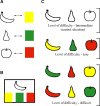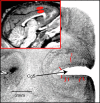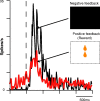Impact of commitment on performance evaluation in the rostral cingulate motor area
- PMID: 17626209
- PMCID: PMC6672598
- DOI: 10.1523/JNEUROSCI.4718-06.2007
Impact of commitment on performance evaluation in the rostral cingulate motor area
Abstract
Performance evaluation is a prerequisite for behavioral adaptation. Although the anterior cingulate cortex (ACC) is thought to play a central role in error detection, little is known about the electrophysiological activity of this structure during the performance-monitoring process. We directly addressed this issue by training monkeys to perform a Stroop-like task and then recorded neuronal activity in the rostral cingulate motor area (CMAr), a relatively unexplored region of the ACC known to be involved in motor processing. We found that most CMAr neurons responded during the evaluation period to both positive and negative feedback, but neuronal changes were more important after an error than after a successful trial. Interestingly, this performance-monitoring activity was not directly modulated by the degree of difficulty of the cognitive situation because changes in discharge frequency were similar whatever the level of attentional control imposed on the monkey. Firing activity during the evaluation period increased more, however, in erroneously completed than in incompleted trials and when the reward was delivered in an active rather than passive context, indicating that performance evaluation was conditioned by the degree of commitment of the animal to the task. It would thus seem that CMAr neurons could constitute a system for the evaluation of behavioral performance contingent on the subject's commitment to the task.
Figures








References
-
- Akkal D, Bioulac B, Audin J, Burbaud P. Comparison of neuronal activity in the rostral supplementary and cingulate motor areas during a task with cognitive and motor demands. Eur J Neurosci. 2002;15:887–904. - PubMed
-
- Brown JW, Braver TS. Learned predictions of error likelihood in the anterior cingulate cortex. Science. 2005;307:1118–1121. - PubMed
Publication types
MeSH terms
LinkOut - more resources
Full Text Sources
